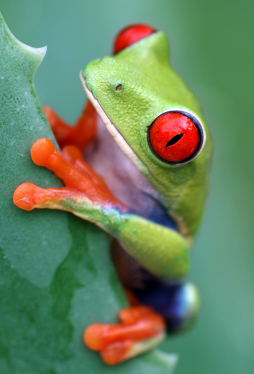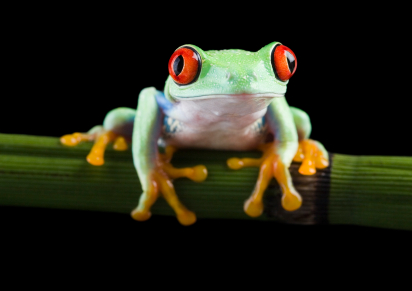Red Eyed Tree Frog - Agalychnis callidryas
The Red Eyed Tree Frog is one of the most brilliantly colored frogs in existence. With their stunning red eyes (thought to be used to startled predators), orange toe pads and blue and yellow striped sides they truly look like an artist’s abstract rendition of amphibian beauty. While amazingly beautiful, caution should be taken before running out and purchasing your very own Red Eyed Tree Frog- they tend to be pricey and rather delicate as well. This is certainly not a species for the first time reptile owner.
DO NOT FEED WILD INSECTS OR INSECTS FOUND AROUND THE HOUSE – THEY MAY CARRY DISEASES THAT COULD BE DEADLY TO YOUR PET
Average Size: Males up to 2 inches, females up to 3 inches.
Life Span: Up to 30 years, average of around 10.|
Description: Red-eyed tree frogs as indicated in the photos have bold red eyes with vertically narrowed pupils, a bright green body with yellow and blue striped sides, and orange toes. Males range from 2 to 2 1/2 inches, while female range from 2 1/2 to 3 inches on average. Young frogs are typically brown in color and turn greener as they mature. As with many reptiles, red-eyed tree frogs have soft, fragile skin. Red Eyed tree frog are members of the Hylidae

Natural Habitat: Red-eyed tree frogs inhabit rainforests from southern Mexico, through Central America, to Northern Colombia. They are often found near rivers or ponds.
Diet: In the wild Red Eyed Tree Frogs will eat just about anything that moves and will fit in their mouth, including insects and other frogs. In captivity a variety of gutloaded, vitamin/ mineral powder coated crickets and meal or wax worms should be provided.
Feeding: Gutloaded, supplement powdered crickets should be the main staple of your Red Eyed Tree Frogs diet, and offered every to every other night just before lights out. Mealworms and waxworms should be fed sparingly; mealworms because they are very fibrous and waxworms because they are extremely high in fat.
Housing: Red Eyed Tree Frogs are an arboreal species, meaning that they spend most of their time in the trees. This means that a cage that is taller than it is wider is most desirable for captive housing. Glass or plexi enclosures are usually the best way to go as they allow maintenance of the high humidity levels that the Red Eyed Tree Frog requires. A portion of the enclosure should be screen however to allow for adequate ventilation to prevent molding and stagnation.
Size: A nice sized cage for a couple of Red Eyed Tree Frogs would be 24 inches long X 18 inches deep X 24 inches high. A cage this size will allow for a pond at the bottom as well as adequate planting.
Substrate: If live plants are going to be used in your Red Eyed Tree Frog enclosure a bioactive substrate or cocofiber will make a great planting base. If not, mulch chips or shredded bark such as can be found in the reptile section of your local petstore will also look nice and help maintain humidity levels. NEVER use pine or cedar chips marketed for small animals such as guinea pigs and hamsters.

Habitat: The more plants and branches (both live and fake) that you place in your frog enclosure the happier your frogs will be. A stunningly beautiful naturalistic setup for Red Eyed Tree Frogs can be made using a water feature, pond, live plants and natural wood branches. Such a thing is a source of beauty in the home as well as a paradise for your frogs. A step down from that would be a basic enclosure with fake plants and a large water dish.
Grooming and Hygiene: None! Handling is neither practical nor recommended. Should you need to move your frogs from one enclosure to another try to handle them for the least amount of time possible. Red Eyed Tree Frogs are a showcase animal, not one that is well- suited for forays outside of the cage. Always wash your hands before and after touching your gecko or habitat contents to help prevent Salmonella and other infectious diseases
Temperature: Red Eyed Tree Frogs prefer a daytime temperature of 75 to 85 degrees F and a nighttime temperature of 65- 75 degrees F. Heat can be provided by the combined use of heat bulbs or ceramic heat emitters and an under the tank heating pad. Heating rocks are extremely dangerous and should never be used.
Lighting: Lighting is more important for viewing your frogs than it is for the frogs themselves. If you wish to keep live plants in your tanks, place a full spectrum bulb on your tank.
Water: Provide either a filtered pond for your Red Eyed Tree Frogs or a large water dish they can soak in. Make sure to place a rock or branch if the water feature is especially large or deep in case your frog falls in. Always make sure to keep the water clean and chlorine free. Mist your frog as many times daily as is needed to keep the humidity between 85 and 100 percent.
Habitat Maintenance: Water change daily, fecal material removal daily, wipe glass daily. Clean cage weekly.
Recommended Supplies:
- Secure glass or plexi enclosure with screen ventilation
- Numerous love or fake plants
- Heat lamp or ceramic heat emitter
- Heating pad for under the tank
- Light housing and bulbs
- Thermometer and humidity gauge
|
- Water bowl, or filter for pond area
- Vitamin/ mineral powder
- Live prey items
- Mister
- Rocks, driftwood for decoration
| Normal Behavior and Interaction: Expect your Red Eyed Tree Frog to have a very low activity level for 99.9% of the time. At night time, however, you will see these living jewels come awake and slowly make their way around their enclosure. Every movement of the Red Eyed Tree Frog is carefully calculated and executed, and seeing them move around on their amazingly delicate, brightly colored legs is a sight to behold. The species is thought to be moderately social and it is recommended that you get your frog a buddy or two for company. The males are smaller than the females, and will call at night if you manage to mimic breeding conditions.
Signs of a Healthy Pet:
|
|
- Eats regularly
- Clear nose and vent
|
Common Health Issues and Red Flags:
- Weight loss or decreased appetite
- Mucus in mouth or nose
- Swelling
- Lethargy
- Bumps, sores, or abrasions on skin
|
- Labored breathing
- Paralysis of limbs
- Abnormal feces
- Stringy or fuzzy material on the skin
- Red spots, blotches or lines
|
Injuries and dietary deficiencies are the most common ailments for the Red Eyed Tree Frogs. Most injuries will heal on their own. In case of severe injury a reptile/ amphibian veterinarian should be contacted. Dietary deficiencies can be avoided by feeding a proper, balanced diet to your frog. The symptoms of a dietary deficiency are indistinct in aquatic frogs and hard to diagnose. Prevention is the best medicine in this case. This is a difficult and delicate species and its captive care should be reserved for the advanced hobbyist.
If you notice any of these signs, please contact your exotic animal veterinarian.
As with all pets in this category, it is important that you find a veterinarian that practices in EXOTICS – this is critical. The typical small animal practitioner may not have sufficient knowledge in this area. Even this guide is general in nature and should not be used to diagnose your pet.
I would like to Thank Genevieve LaFerriere for writing this caresheet. She breeds and sells geckos, visit her website: http://gensgeckos.tripod.com/
|



